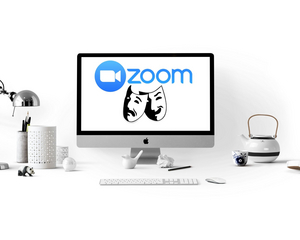BWW Blog: Adapting a Theatre Lesson Plan for Online Learning
If an employer asked me if I had any experience with teaching on Zoom, I could now say yes.

The spring 2020 semester did not end up the way anyone imagined. Having to transition to all online classes with very short notice was less than ideal. Some had it easier than others. Some classes could be taught and learned in an online format just as easily as they were in person. In my experience theatre classes are just not the same through a screen. There are different styles of learning, and I tend to be a kinesthetic learner, meaning hands-on. This made classes such as Tap, Directing, and Voice Lessons more difficult, because I was not able to get up on my feet with others and activate muscle memory. While I still did learn from what we did through Zoom classes and such, it was less impactful than being in the room. This experience did however help me understand what other students, including the ones I taught, were going through.
One of my other classes of this semester was Methods of Teaching Drama, A.K.A, how to be a theatre teacher. For our final, we were split into pairs to teach a lesson on different stages of the theatrical process. Due to the pandemic, we were not able to step into the classroom as promised, but we were still able to teach our lessons through Zoom, they just had to be modified a bit.
My co-teacher/good friend Christine, and I, originally planned our lesson to be blocking the student's stories, which they had written in the previous lesson. However, because of the shift to online learning, we had to adapt our lesson to make it something less reliant on them being up on their feet. The lesson before ours was still having them write monologues, and we still wanted to workshop them in some way. It took us some time to decide how exactly to do that, but I was very grateful when Christine had the idea to focus on tone, which she had been talking about in her Acting 3 class. From that, I suggested we bring up the importance of it when acting on a screen versus acting in person. With this lesson, the worksheet we wanted to make and the video explanation to accompany it came to us easily.
As far as the recording of the first part of the lesson went, I enjoyed it. Christine and I wrote up a script, so we knew who would be saying what and went from there. This is something I would consider doing as a professional. If I knew I was going to be absent on a day I had a lecture planned, recording it ahead of time could be an option. I think this is something that more teachers should utilize, whether their learning is based online or not.
When we had our live lesson, I felt like we did our best. We were teaching a group of students from a Montessori school, where the approach to learning is hands-on, so we understood if they struggled to rely solely on visual and auditory learning. Their teacher did message us midway through to say that we were doing well and that the students had not been responsive lately, which was reassuring. At the end of the lesson, their teacher was able to relate our lesson to history class, which the students seemed to connect with more, so I am glad she was able to help us get our point across.
Overall teaching online was good, as I like to get as many new teaching experiences as I can, to better prepare myself for the future. If an employer asked me if I had any experience with teaching on Zoom, I could now say yes. It also got some of my nervousness about teaching a real class out of the way and prepared me for the possibility of having to student teach online.
Videos


